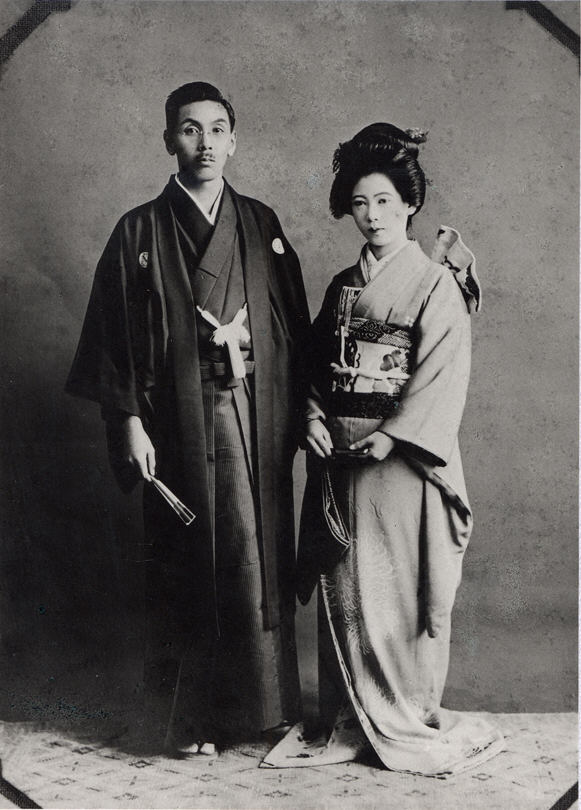
Pin on china
Japanese clothing during the Meiji period A woodblock print by Yōshū Chikanobu showing Japanese women in Western-style clothes, hats, and shoes ( yōfuku)

Taisho Roman Japanese history, Taisho era, Taisho period
Japanese Fashion Through the Years Read the Story There's a lot more to Japanese fashion than you can imagine. Let's take a look at some major points of fashion in Japan.

Overcoat (Tonbi), Taishō period (191226) to Shōwa period (192689
Taishō eraTaishō jidai [taiɕoː dʑidai] was a period in the history of Japan dating from 30 July 1912 to 25 December 1926, coinciding with the reign of Emperor Taishō [1] The new emperor was a sickly man, which prompted the shift in political power from the old oligarchic group of elder statesmen (or Imperial Diet of Japan.

Wa Lolita Casual Japanese Taishō Period Arrow Patterned Slope Etsy
The Taisho period is a short period in Japanese history between 1912 to 1926. It was the years of democratic movements across the political, economic and cultural fields. Many dramatic changes had been made during this period which gave huge impacts also on Japanese lifestyle; it became westernized and people started to wear western clothes and.

Kimono Ensemble with Chrysanthemums Japan Taishō period (191226
Source over 2 million products in more than 40 product categories. Contact Verified Suppliers Online. Millions of Products at Factory Prices.

Taisho Era Fashion in Yono r/japanpics
Taisho Era| History, Culture, and Art of This Period By Janbox - 05/05/2022 3222 Japanese culture since ancient times has brought many unique and distinctive features.

Kimono HIME scans taisho style Japanese outfits, Modern kimono
Taisho Era (1912-1926) As the Taisho empire continued, modern living thrived. The dawn of radio, magazines and cinema inspired fresh styles such as decorated collars and new patterns. The West and the East began to share trends and by the end of the 1920s favoring a glamorous slim line with vertical draping in gowns, robes and dresses.

Exclusive Japanese Fashion Style Midi Dress Taishō Period Women Chic
The uptake of yofuku (Western clothing) filtered down through the classes, however many women found the new fashions impractical for Japanese living and for decades to come it was still common for women to wear kimono, increasingly paired with contrasting accessories like hats, scarves, gloves, umbrellas and handbags. Taisho: 1912-1926

Male Kimono, Yukata Kimono, Japanese Costume, Japanese Kimono, Japanese
Taisho Era Fashion Trends: Unveiling Japan's Unique Style Statements 22 The Taisho Era: A Fusion of Tradition and Modernity 23 Western Influences on Taisho Fashion 24 The Rise of Moga: Modern Girls in Taisho Fashion 25 Traditional Influences in Taisho Fashion 26 7. World War II's Influence on Japanese Fashion: Navigating Occupation and Change

A photo of a modern woman of the Taisho period (19121927), Japan
With the influx of clothing in the Meiji era (1868-1912), kimono gradually became an outfit worn on special occasions such as weddings, funerals, and other special occasions. 02. The period from the Taisho era to the early Showa era saw the introduction of Western culture in various forms including the introduction of chemical.

Emperor Taisho the Order of the Garter Emperor Taishō Wikipedia
While the anime takes place in the Taisho era, about when Western-style fashion became vogue in cities, the origins of Western and syncretic fashion in Japan can be found in the preceding Meiji.

Japan Fashion, 1930s Fashion, Vintage Fashion, Fashion Women
Emergence of Modan Gāru Following the city's reconstruction after the disastrous earthquake, young girls who were sensitive to Western-influenced trends, known as modan gāru, or moga for short, started to appear in the 1920s.Dressed in the cutting-edge Western clothes and hats with cropped hair (Figure 9), Anzō Yūko and Koizumi Makiko argue that they became the symbol of modern.

Japanese Fashion Wa Lolita Retro Taishō Period Style High Etsy
In the 19th century, traditional Japanese clothing consisted of a kimono for both men and women. The kimono is a long robe-like garment that is wrapped around the body and secured with a sash called an obi. The fabric used for the kimono varied according to the season and occasion.

Kimono Japan, Taisho period (19121926) to Shōwa period (19261989
Listen to the episode to find out!# Taisho Era (1912-1926) Image Source. While the Meiji Era bombarded the Japanese with momentous modernizations day after day, and the Edo Era represented the old traditions, the Taisho Era struck a nice balance between the two. Even though this era was short-lived, it made quite an impact.

Japanese Style Fashion Maxi Skirt Taishō Period Style Green Pleated
In the latter part of the Edo era, the government banned people from wearing ostentatious kimonos, so people adopted kimonos with plain patterns like stripes and chequered patterns. During the Meiji and Taisho era (mid-1800s to 1920s), the arrival of Western culture changed many aspects of Japanese society, including fashion.

These retroinspired kimono are a throwback to the large bold prints
Download the Temu App and start saving more today! Unleash incredible deals and coupons. Discover unbeatable deals and discounts on the Temu App. Download Now & Save Big!